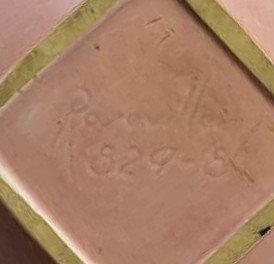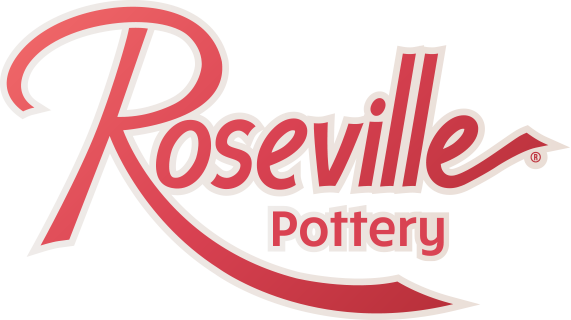
Factory Marks and Labels Used by Roseville Pottery
Nearly every pottery company, and indeed even the craftsmen and guild throughout history provided for some way to identify the providence of the wares they produced. Whether painted, molded, carved, or stamped, whether shape numbers or companies, artists or clay color, marks of all kinds can tell us volumes about a piece, if the information about them is available. It is for that reason we provide this guide to the marks used by the Roseville Pottery Company.
Although The Roseville Pottery Company was in business beginning in 1892, their early wares were unmarked. It was not until the majolica A & P "vase assortments" were released in 1896 that the first labels appear. They were simple paper stickers, with the letters "RPCo" in a scroll. The second stickers were the "rectangle" stickers, found on their majolica jardinieres, umbrella stands, and cuspidors.
In 1900, Roseville began producing their under glaze-decorated brown-ware under the "Rozane" brand, and used a simple ROZANE die-stamped mark in the base. In 1903, with the arrival of the blue-tinted Azurean line came the occasional die-stamped AZUREAN mark, although most received no identifying mark. In 1904, some of the Chloron line pieces were given a blue ink-stamp with "Chloron" and "TRPCo" in cursive.
Later in 1905 an attempt was made to standardize their marks with the "Wafers". These "Wafers" were clay-molded pieces that were attached to the bases of the various products. Each of the five major lines had a rocker added to the bottom of the wafer identifying that particular line. These five lines were: Egypto, Royal, Mongol, Mara, and Woodland. Around 1906 the rockers were abandoned, and most of the artware received the standard "Rozane ware" wafers, expanding to such lines as Della Robbia, Aztec, and Crystalis. The major exception was the Olymipic line, which received a three line ROZANE "OLYMPIC" POTTERY hand-printed in ink under the glaze..
Beginning around 1910 the application of the blue Rv ink-stamp became fairly common across many of the lines until 1928. In 1914 The early "shield" stickers were introduced and were used well into the 1930's. The popularity of the Donatello line in 1915 prompted it to occasionally receive it's own "Donatello" wafer-style impression. From 1930 until about 1937 the later shield sticker which included the ""Rv" trademark was used extensively.
Beginning in 1936 and continuing until around 1938, the incised Roseville marks appear. It is interesting to note that during this transitional period examples of many pieces can be found with either no marking or with the Roseville mark. This led to a great deal of confusion for early collectors before the actual dates of production for the various lines were known. These marks can be found on Pinecone, Dawn, Iris, Fuschia, Teasel, and a few others, some of which can also be found unmarked and with a shield sticker.
During the period from 1939 and continuing until their bankruptcy in 1954, the raised Roseville USA marks appear. The raised Roseville USA marks are certainly the most recognizable to collectors. Some patterns can be found during the transition with either raised USA or incised without USA marks such as Cosmos. One of the last of the floral patterns, Mock Orange was introduced in 1951, and with it came an unusual mark. Many of the pieces from this pattern are actually marked as "Mock Orange" in the mold along with the typical Roseville USA and shape number.
The Raymor line of cookware was introduced in 1953, and Roseville added both Raymor and other marks to the base such as PATPEND.
After their bankruptcy in 1954, the Roseville name passed to a group of Connecticut businessmen, who produced the Keynote line through 1956. These pieces were generically marked without even the Roseville trademark use.
With the failure of the Connecticut keynote lines, a long night fell upon the Roseville brand. For several decades no pottery branded as Roseville was created, and the trademark expired. Beginning around 1970, a small number of antique devotees began collecting Roseville, and by the late 1980's prices began rising. By the early 1990's it became almost a craze, and collectors sought more than was available. It was this environment that gave rise to the import Roseville. Several businesses had already established themselves in the states with the model of selling reproduction popular antiques. It did not take them long to take advantage of the expired trademark, and they ordered hundreds of thousands of reproduction pieces from Chinese factories. They spread them generously through antique malls, retail outlets, and especially auctions. There were many variations on the Roseville marks, and some are shown below for identification.
Another group of marks to examine are trial marks. These are usually beneath the glaze in crayon, with series of numbers which are believed to correspond to specific color combinations. The pieces marked as as trials or that have trial numbers can have wildly different color schemes or designs than production pieces.
-

Vase Assortment
Also known as Victorian, the shape number is impressed in the mold in an old-style cursive. ca. 1896-1900
-

Scroll Label
The "Scroll" paper label has been found occasionally on Vase Assortment products. ca. 1896-1900
-

Rectangle Label
The early Roseville Pottery "rectangle" paper label is sometimes found on Majolica jardinieres, ca. 1900-1904
-

Rozane Stamped
Pre-1905 Rozane brown-ware received a stamped Rozane RPCo mark. ca. 1900-1904
-

Azurean Mark
Typical Azurean base ca. 1903-1904
-

Chloron Cursive Ink
Typical Chloron base ca. 1905
-

Rozane Ware Wafer
Roseville Rozane wafer, Ca 1905-1908
-

Rozane Egypto Wafer
Roseville Rozane Ware Egypto wafer, Ca 1905-1906
-

Rozane Royal Wafer
Roseville Rozane Ware Royal wafer, Ca 1905-1906
-

Rozane Woodland Wafer
Roseville Rozane Ware Woodland wafer, Ca 1905-1906
-

Rozane Mongol wafer
Roseville Rozane Ware Mongol wafer, Ca 1905-1906
-

Rozane Olympic Pottery Mark
Roseville Rozane Olympic Pottery mark, Ca 1906
-

Roseville Rv Ink-stamp
Stamped blue ink Roseville Rv Mark, Ca 1910-1928
-

Early silver label
Roseville early metalic silver label, Ca 1914-1933
-

Roseville Donatello Mark
Roseville Donatello RPco stamped mark, Ca 1915
-
Later Silver Label
Roseville later metallic silver label with Rv, Ca 1930-1937
-

Typical Crayon Mark
Roseville crayon mark indicating shape number, Ca 1925-1935
-

Roseville Incised Mark
Roseville incised mark with shape number, Ca 1936-1938
-

Roseville Raised Mark
Roseville raised mark with USA and shape number, Ca 1939-1954
-

Roseville Mock Orange
Mock Orange with Roseville USA and shape number, Ca 1951-1954
-

Roseville Raymor
Roseville Raymor with PATPEND, shape number, and ovenproof, Ca 1953-1954
-

Roseville Keynote
Roseville Keynote, marks include USA and shape number only. Ca 1955-1956
-

Import Roseville, Raised Mark
Import Roseville, raised mark with no USA, Ca 1990-2010
-

Import Roseville No USA
Import Roseville, raised mark no USA or shape number, Ca 1990-2010
-

Import Roseville with USA
Import Roseville, raised mark with USA and shape number, Ca 1990-2010
-

Import Roseville no USA
Import Roseville, raised mark with shape number, no USA, Ca 1990-2010
-

Import Roseville Incised
Import Roseville, incised no USA, Ca 1990-2010
-

Trial Color Marks
Trial Color Marks in crayon under glaze, Ca 1945
-

Trial Shape Marks
Trial Shape Marks, crayon under glaze, Ca 1937
If you have more questions, we are certain you will find the answers in the following books. Each of these books is highly recommended for collectors of Roseville Pottery. The owners of this website may receive compensation for qualified sales of the books.





